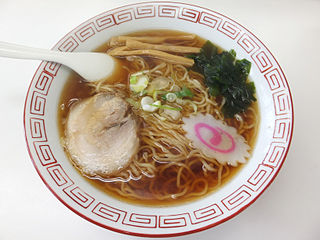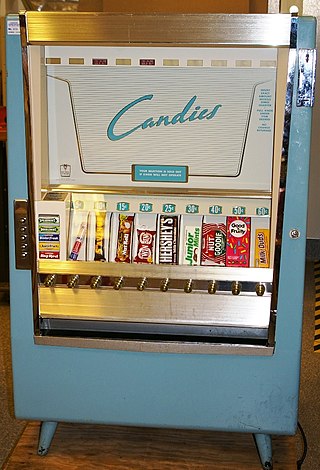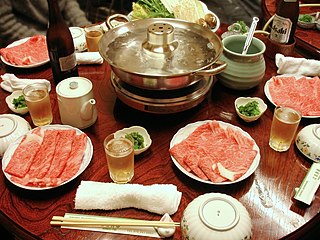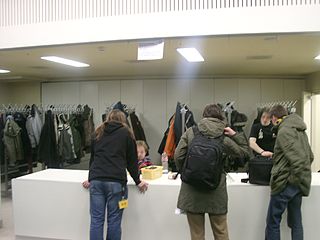
Shokken (食券 "food ticket") are a type of Japanese ticket machine/vending machine, usually used at restaurants for ordering food.

Shokken (食券 "food ticket") are a type of Japanese ticket machine/vending machine, usually used at restaurants for ordering food.
Shokken machines were first seen in 1926 at Tokyo Station [1] There are currently over 43,000 shokken machines in Japan. [2]
Shokken are often found in restaurants, cafes, fast-food restaurants and other establishments. A typical shokken machine features buttons where the customer can select an item, a coin slot, where the customer can pay for the item and a printer where the customer can receive their receipt. Upon receiving their receipt, the customer can then exchange their receipt for their purchased item. [3] [4] [5] [6] [7] [8] Shokken machines can be standalone machines and sometimes are located on countertops and tables. [9]

Companies often use shokken machines as they can reduce the amount of staff needed, reduce theft, reduce the turnover rate and can help reduce ordering errors. [10] While useful, shokken machines are not associated with a fine dining atmosphere, [10] as they are often seen in inexpensive restaurants such as Matsuya, Yoshinoya and Sukiya. Shokken machines also can break and limit customized orders. [9] [11]

Japanese cuisine encompasses the regional and traditional foods of Japan, which have developed through centuries of political, economic, and social changes. The traditional cuisine of Japan is based on rice with miso soup and other dishes with an emphasis on seasonal ingredients. Side dishes often consist of fish, pickled vegetables, and vegetables cooked in broth. Common seafood is often grilled, but it is also sometimes served raw as sashimi or as sushi. Seafood and vegetables are also deep-fried in a light batter, as tempura. Apart from rice, a staple includes noodles, such as soba and udon. Japan also has many simmered dishes, such as fish products in broth called oden, or beef in sukiyaki and nikujaga.

Ramen is a Japanese noodle dish. It includes Chinese-style wheat noodles served in a broth. Common flavors are soy sauce and miso, with typical toppings including sliced pork, nori, menma, and scallions. Ramen has its roots in Chinese noodle dishes and is a part of Japanese Chinese cuisine. Nearly every region in Japan has its own variation of ramen, such as the tonkotsu ramen of Kyushu and the miso ramen of Hokkaido.

Chazuke or ochazuke is a simple Japanese dish made by pouring green tea, dashi, or hot water over cooked rice. Common toppings include tsukemono, umeboshi, nori (seaweed), furikake, sesame seeds and tarako, salted salmon, shiokara, scallions, and wasabi.

A vending machine is an automated machine that dispenses items such as snacks, beverages, cigarettes, and lottery tickets to consumers after cash, a credit card, or other forms of payment are inserted into the machine or payment is otherwise made. The first modern vending machines were developed in England in the early 1880s and dispensed postcards. Vending machines exist in many countries and, in more recent times, specialized vending machines that provide less common products compared to traditional vending machine items have been created.

A take-out or takeout ; carry-out or to-go ; takeaway ; takeaways ; grab-n-go; and parcel is a prepared meal or other food items, purchased at a restaurant or fast food outlet with the intent to eat elsewhere. A concept found in many ancient cultures, take-out food is common worldwide, with a number of different cuisines and dishes on offer.

Fast food is a type of mass-produced food designed for commercial resale, with a strong priority placed on speed of service. Fast food is a commercial term, limited to food sold in a restaurant or store with frozen, preheated or precooked ingredients and served in packaging for take-out or takeaway. Fast food was created as a commercial strategy to accommodate large numbers of busy commuters, travelers and wage workers. In 2018, the fast-food industry was worth an estimated $570 billion globally.
Suica is a prepaid rechargeable contactless smart card and electronic money system used as a fare card on train lines and other public transport systems in Japan, launched on November 18, 2001, by JR East. The card can be used across the nation as part of Japan's Nationwide Mutual Usage Service. The card is also widely used as electronic money for purchases at stores and kiosks, especially at convenience stores and within train stations. In 2018, JR East reported that Suica was used for 6.6 million daily transactions. As of October 2023, 95.64 million Suica have been issued, and 1.63 million stores accept payment via Suica's digital currency.

Naan is a leavened, oven-baked or tawa-fried flatbread, that can also be baked in a tandoor. It is characterized by a light and fluffy texture and golden-brown spots from the baking process. Naan is found in the cuisines of Central Asia, South Asia, Southeast Asia, and the Caribbean.

A ticket machine, also known as a ticket vending machine (TVM), is a vending machine that produces paper or electronic tickets, or recharges a stored-value card or smart card or the user's mobile wallet, typically on a smartphone. For instance, ticket machines dispense train tickets at railway stations, transit tickets at metro stations and tram tickets at some tram stops and in some trams. Token machines may dispense the ticket in the form of a token which has the same function as a paper or electronic ticket. The typical transaction consists of a user using the display interface to select the type and quantity of tickets and then choosing a payment method of either cash, credit/debit card or smartcard. The ticket(s) are then printed on paper and dispensed to the user, or loaded onto the user's smartcard or smartphone.

Conveyor belt sushi, also called rotation sushi, is a type of sushi restaurant common in Japan. In Australasia, it is also known as a sushi train.

An automat is a type of fast-food restaurant where food and drink are served through a vending machine, typically without waitstaff. The world's first automat, Quisisana, opened in Berlin, Germany in 1895.

Shabu-shabu is a Japanese nabemono hotpot dish of thinly sliced meat and vegetables boiled in water and served with dipping sauces. The term is onomatopoeic, derived from the sound – "swish swish" – emitted when the ingredients are stirred in the cooking pot. The food is cooked piece by piece by the diner at the table. Shabu-shabu is generally more savory and less sweet than sukiyaki, another hot pot dish.

Taspo (タスポ), formerly known as Tobacco Card, is a smart card using RFID developed by the Tobacco Institute of Japan (TIOJ), the Nationwide Association of Tobacco Retailers, and the Japan Vending Machine Manufacturers Association for introduction in 2008. Following its introduction, the card is necessary in order to purchase cigarettes from vending machines in Japan. The name "Taspo" is a portmanteau for "tobacco passport".

Etiquette in Japan forms common societal expectations of social behavior practiced throughout the nation of Japan. The etiquette of Japan has changed greatly over the millennia as different civilizations influenced its culture. Modern Japanese etiquette has a strong influence from that of China and the Western world, but retains many of its unique traditional elements.

A cloakroom, known as a coatroom and checkroom in North America, is a room for people to hang their coats, cloaks, canes, umbrellas, hats, or other outerwear when they enter a building. Cloakrooms are typically found inside large buildings, such as gymnasiums, schools, churches or meeting halls.

Yakiniku, meaning "grilled meat", is a Japanese term that, in its broadest sense, refers to grilled meat cuisine.

Sanrio Puroland, also known as Hello Kitty Land, is an indoor theme park located in Tama New Town, Tokyo, Japan. Opened on December 7, 1990, it hosts attractions, live shows, shopping outlets, and restaurants dedicated to Sanrio characters such as Hello Kitty, My Melody, Cinnamoroll, Gudetama, and Aggretsuko, in a manner akin to Disney theme parks.

Echigo-Yuzawa Station is a railway station operated by East Japan Railway Company, located in the resort town of Yuzawa in Niigata Prefecture, Japan. The station is located 199.2 kilometres (123.8 mi) from Tokyo.
An automated restaurant or robotic restaurant is a restaurant that uses robots to do tasks such as delivering food and drink to the tables and/or cooking the food.

Reborn as a Vending Machine, I Now Wander the Dungeon is a Japanese light novel series written by Hirukuma and illustrated by Itsuwa Kato and Yūki Hagure. The series was originally published in 2016 as a web novel by the author on the user-generated novel publishing website Shōsetsuka ni Narō. Later on the same year, it was acquired and then published by Kadokawa Shoten. A manga adaptation by Kunieda began serialization ASCII Media Works's shōnen manga magazine Dengeki Daioh in August 2021. Both the light novel and manga have been licensed in English by Yen Press. An anime television series adaptation by Studio Gokumi and AXsiZ aired from July to September 2023. A second season has been announced.